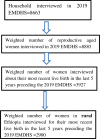Utilization and factors associated with health facility delivery among women of reproductive age in rural Ethiopia: Mixed effect logistic regression analysis
- PMID: 37450432
- PMCID: PMC10348594
- DOI: 10.1371/journal.pone.0280660
Utilization and factors associated with health facility delivery among women of reproductive age in rural Ethiopia: Mixed effect logistic regression analysis
Abstract
Background: Worldwide over 800 women lose their life each day from complication in pregnancy and child birth. Health facility delivery is one of the key strategies for reducing maternal mortality and for ensuring safe birth. Inequity by urban-rural residence is one of the most pronounced challenges in maternal health service coverage with women living in rural areas at a greater disadvantage than other women. This study aims to assess the magnitude and factors affecting the utilization of health facility delivery for the most recent live birth among women of reproductive age in rural Ethiopia.
Methods: This is a cross-sectional study based on a data from Ethiopian Mini Demographic and Health Survey 2019 dataset with a total weighted sample of 2900 women of reproductive age group in rural Ethiopia. Data cleaning, coding and labeling were done using STATA version 14 software. Multilevel mixed effect logistic regression model was employed to identify associated factors.
Result: Only 44% of reproductive-age women in rural Ethiopia gave their most recent live birth in health institutions. In the multivariable multilevel binary logistic regression analysis; educational status, wealth index, attending 4+ANC, and had ANC from skilled provider were found to be statistically significant factors associated with health facility delivery.
Conclusion: In a rural part of Ethiopia, the prevalence of institutional delivery is low. Especial emphasis should be given for mothers with no formal education, and poor household wealth index, Furthermore, implementing public health programs that target to enable women to have more frequent Antenatal Care follow-up from skilled providers may increase the number of health facility deliveries.
Copyright: © 2023 Birhan Ewunu Semagn. This is an open access article distributed under the terms of the Creative Commons Attribution License, which permits unrestricted use, distribution, and reproduction in any medium, provided the original author and source are credited.
Conflict of interest statement
The authors have declared that no competing interests exist.
Figures


References
-
- WHO U. UNFPA, World Bank Group and the United Nations Population Division. Trends in maternal mortality 2000 to 2017: estimates by WHO, UNICEF. UNFPA, world bank group and the United nations population division. Geneva: …; 2019.
-
- Amdie FZ, Landers T, Woo K. Institutional delivery in Ethiopia: Alternative Options for Improvement. International Journal of Africa Nursing Sciences. 2022:100436.
-
- Organization WH. World health statistics 2016: monitoring health for the SDGs sustainable development goals: World Health Organization; 2016.
MeSH terms
LinkOut - more resources
Full Text Sources
Medical

